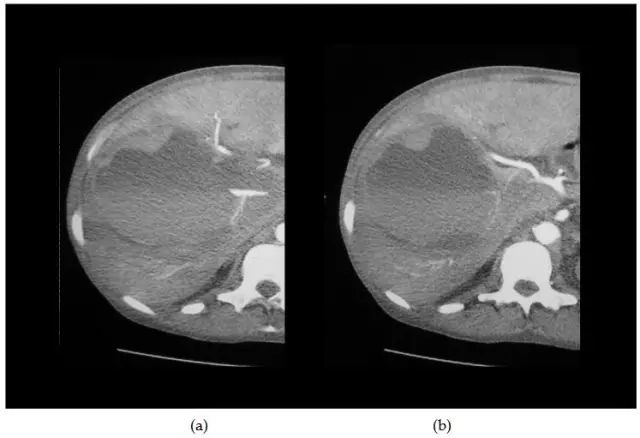- Author Rachel Wainwright [email protected].
- Public 2023-12-15 07:39.
- Last modified 2025-11-02 20:14.
Spermogram
Spermogram is a detailed analysis of the ejaculate (semen), the study of sperm under a microscope. This analysis allows you to assess a man's fertility, that is, his ability to conceive. Deviations of spermogram indices from the norm indicate a decrease in the possibility of conceiving naturally. However, such deviations do not exclude the possibility of conception. Changes in sperm morphology, physical and chemical properties of the ejaculate, and the presence of foreign components in the semen lead to a decrease in fertility.
Preparation for spermogram
Three to five days before the study, alcohol, drugs, especially antibiotics should be excluded. It is forbidden to visit the bathhouse and sauna, as overheating of the sperm will lead to their death. Excessive excitement and stress should be avoided before research. For this period of time, abstinence is mandatory.
Masturbation is considered to be the main method of obtaining ejaculate for semen analysis. In preparation for the study, collect all the sperm that was released during ejaculation. Semen for spermogram (with the very first and very last portion) is collected in a plastic sterile container. The reliability of the semen analysis results directly depends on the transportation conditions, as well as on the time after which the container was delivered to the laboratory. It is preferred that the container is delivered within twenty minutes of ejaculation. You should not receive semen for spermogram through interrupted intercourse, oral intercourse, intercourse in a condom. Saliva, condom latex components, and vaginal discharge can negatively affect the quality of ejaculate. To obtain a reliable and objective result, it is necessaryso that the spermogram is performed four times with an interval of two weeks.
Spermogram standards
The following values of the main indicators are considered the norms for spermogram:
- semen volume (up to 4 ml);
- semen viscosity (up to 0.5 cm);
- sperm concentration (more than 20 million in 1 ml of semen);
- sperm count (over 60 million in semen);
- sperm motility (A> 25% or A + B> 50%);
- sperm morphology (more than 20%);
- live sperm count (over 50%);
- the number of spermatogenesis cells (up to 2%).
Spermogram decoding
In the study, first of all, the sperm liquefaction time is checked. With an increase in the liquefaction time, sperm cells gain their full-fledged mobility longer. With very thin semen, the chance of fertilization is significantly reduced. The semen viscosity is determined by the length of the thread formed by the sperm when draining from a special needle or pipette. An increase in ejaculate viscosity is usually observed with chronic inflammation of the gonads - vesiculitis or prostatitis.
Thick semen according to the spermogram indicates a possible male infertility. To determine the viscosity of the semen, it is collected in a syringe and released through a special needle. Ejaculate volume is very important for analysis. The optimal volume is the volume of ejaculate up to 4 ml. A small amount of semen secreted indicates a very poor fertility and a problem with male health. A decrease in semen volume indicates insufficient function of the seminal vesicles, the prostate gland. Excess ejaculate volume may be associated with an inflammatory process in the gonads.
Normal semen color is yellowish, white or grayish. The appearance of a brown or red tint of sperm occurs in chronic vesiculitis, calculous form of prostatitis, genital trauma. The yellow color of semen becomes when using food dyes and certain medicines.
Sperm count indicates the possibility of conception. You can count the sperm count using a special microscope. The normal number is considered to be twenty million sperm in one millimeter of ejaculate.
When decoding spermograms, special attention is paid to sperm motility. After all, the most motile spermatozoa are more likely to connect with the egg. A spermogram helps to determine the number of abnormal sperm.
Reproductive disorders are determined by the acidity of the semen. According to the spermogram, the normal sperm pH should be from 7.2 to 7.8. A deviation in pH from the norm indicates a possible inflammation of the gonads (vesiculitis, prostatitis).
A decrease in the number of sperm according to the spermogram is called oligospermia. Oligospermia usually indicates decreased testicular performance. The work of the testicles can be depressed due to a decrease in the concentration of male sex hormones in the blood, the inflammatory process, the transferred toxic damage to the epithelium of the testicles, changes in metabolism. Polyzoospermia - increased sperm count (over 120 million / ml).
Sperm motility is the most important indicator of the spermogram. By mobility, sperm are usually divided into four groups:
- group A - active spermatozoa with rectilinear movement;
- group B - sedentary spermatozoa with rectilinear movement;
- group C - sedentary spermatozoa with rotational or oscillatory movement;
- group D - immotile spermatozoa.
Asthenozoospermia is a decrease in sperm motility. Sperm motility can be reduced from various diseases and various kinds of thermal and toxic effects on the testes.
Sperm morphology is considered a very important indicator of the semen analysis. This indicator of the spermogram reflects the percentage of sperm capable of fertilization. Necrospermia is a decrease in the concentration of live spermatozoa. Agglutination (sperm adhesion) can be observed in chronic inflammatory processes in the male gonads. With agglutination, sperm motility is almost always reduced.
Evaluation of spermogram results

The spermogram is usually deciphered by an andrologist. If, when decoding the spermogram, all indicators are within the normal range, then the chances of a quick and successful conception are quite high. If there are any deviations, then after about a month a re-examination is prescribed. Since spermogram results can vary, final conclusions can only be drawn after two or three studies. It is worth noting that only based on the results of a spermogram it is impossible to make a clear diagnosis, since the probability of conception depends on many other factors - the woman's reproductive health, the frequency and duration of intercourse, as well as the age and condition of the patient.
Found a mistake in the text? Select it and press Ctrl + Enter.






